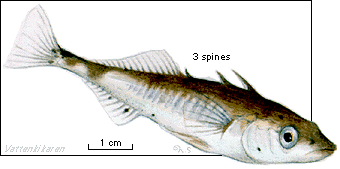|

Distribution in scandinavian waters
|
Maximum length: 11 cm.
Appearance: The three-spined stickleback has a blue green-brown
black colour along its dorsal regions, while the sides and abdomen have
a silver lustre. During the spawning season between March and August
the males are red underneath. During this period the females can have
a brownish colour and cross-wise markings over the dorsal. Besides the
three dorsal spines, the pectoral fins have been replaced by two spines.
The black markings on the skin of the fish are
caused by a parasite that stimulates the fishes own
production of melanin.
At a distance the three-spined stickleback can easily
be mistaken for a nine-spined stickleback or a
little herring.
Depth: Sea-level and a few metres down.
Environment: Usually found in large shoals close to the shore
in both freshwater and saltwater.
Misc: Sea living sticklebacks can wander into freshwater to spawn.
The male builds a nest where one or more females lay their eggs.
Sticklebacks mainly eat small plankton. On
rare ocassions they can be as old as four years.
Classification: The three-spined stickleback is part of the group
spiggar, which is part of the boney fish group under the vertebrates.
|


